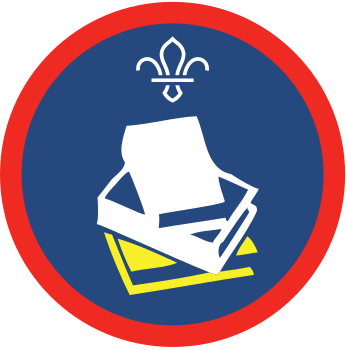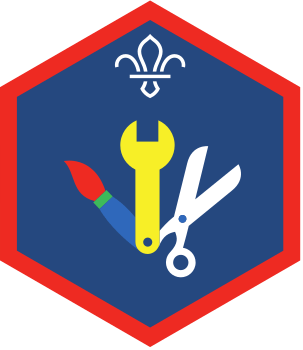The amazing library race
You’ll need
- Scrap paper
- Pens or pencils
- Scissors
Before you begin
- You’ll need to find your local library before you get stuck in. Enter your postcode on the government website to find council libraries near you, or contact local schools, colleges, or universities and ask if they can help.
- Check the opening times of the library you’ve chosen and ask the staff if you can arrange a visit. You could ask about visiting ‘after hours’ if their usual hours don’t match your meeting time (and it may be easier to have the library to yourselves so you don’t disturb others). If this isn’t possible, you’ll have to be flexible to make it work.
- Make sure the space is accessible for everyone in your group. For example, is there a step free entrance? What about accessible toilets or a quiet space?
- Before the visit, explain your ideas and send over all of the activity information. The library staff may have activities they’d like to run, or they may want to chat about services or events, so leave time for this.
- Think about library challenges for the race before the session.
- Don’t forget to complete a risk assessment. The library staff should be able to help with venue-specific information. They may be able to offer you a chance to check the venue out before the visit if it’s not usually open to members of the public.
Dewey belong together?
- Everyone should split into groups of three or four.
- The person leading the activity should introduce the Dewey Decimal Classification system, including its 10 classes.
- Everyone should think of unusual facts or interesting stories about themselves.
- Each group should choose a few people to tell an unusual true (non-fiction) fact or story. They should choose a few people to tell an untrue (fictional) fact or story.
- Everyone should take it in turn to share their fact or story. The other groups should quickly decide whether they think it’s fiction or non-fiction.
- Once each group’s shared their decision, the person sharing the fact or story should reveal the truth.
- Each group should try to write a call number for the story. They should jot it down on a scrap of paper.
- Everyone should repeat steps five to seven until everyone’s shared their fact or story (or they run out of time and need to move on!).
- Each group should take the call numbers they’ve written and try to put them in the order they’d be on a library shelf. They should think about why fiction and non-fiction books are shelved separately.
Time to race
- Everyone should split into small groups. The person leading the activity should give each group a copy of the library challenges they prepared earlier, and a pen or pencil.
- Before the race begins, the person leading the activity should explain how to use the library catalogue. They should stick around in case anyone needs any help during the challenge (but they shouldn’t do any of the challenges for people).
- Everyone should work through the challenges in their groups. The first team to finish should get some bonus points – but the winners are the ones who get the most points.
- Everyone should count their points and congratulate the winners.
- Everyone should put any books away in the right place and thank the library staff for their help.
In libraries, books are given a ‘call number’ to help arrange them on the shelves.
- Fiction books are usually shelved with ‘F’ followed by the first three letters of the author’s surname.
- Non-fiction books are shelved using the Dewey Decimal Classification (DDC) number and then the first three letters of the author’s surname.
The DDC puts books in order by subject. It uses numbers from 000 to 999. For example, 135 is dreams and mysteries, 560 is dinosaurs, and 793 is magic tricks. It also includes numbers to the right of the decimal point to give more detail. It has 10 main classes:
- 000s – Computer science, information and general works
- 100s – Philosophy and psychology
- 200s – Religion
- 300s – Social sciences
- 400s – Language
- 500s – Natural science and mathematics
- 600s – Technology
- 700s – Arts and recreation
- 800s – Literature
- 900s – History and geography
Ideas for library challenges
Remember, to meet the Scouts Librarian Activity Badge requirements the challenges should cover using the library catalogue and looking after books and e-readers. For example:
- Find a damaged book and ask the librarian how to fix it. If it’s possible, carry out the repair.
- Find specific books from just the title or author (hint: think about the library catalogue).
- Find out the library opening times.
- Find out how to borrow an e-book from the library, if they offer this service.
- Find out how to read e-books and take care of an e-reader.
- Find out what the next three library events are. When are they taking place, and how can people join in?
- Check out a specific book.
- Find a specific audiobook or DVD.
- Replace someone’s face with a picture book cover and take a photo.
- Use a book to find out something that happened on this day in history.
- Write the name of a book about each continent on earth. There’s a bonus point for anyone who can find a fantasy land too.
- Use book titles to make a Scout Law – you can only use one word from each title. Write the call number for each book, then challenge another team to find the books and figure out which Scout Law their titles spell.
Reflection
This activity needed everyone to problem-solve. As everyone puts away the books, they should chat about the challenge. Was what the trickiest part? What did people do when they weren’t sure about something? For example, people may have asked the librarian for help. What information did people need to find a book?
This activity also needed everyone to be a team player. What do people this is more important: winning a game, or working well as a team? Did people find it easy to work together? How could groups have worked together better? In teams, different people work differently – a mix of people often makes the best team. Did anyone notice someone in their group doing something they find difficult (or helping someone else)? People should share their examples.
Safety
All activities must be safely managed. You must complete a thorough risk assessment and take appropriate steps to reduce risk. Use the safety checklist to help you plan and risk assess your activity. Always get approval for the activity, and have suitable supervision and an InTouch process.
- Active games
The game area should be free of hazards. Explain the rules of the game clearly and have a clear way to communicate that the game must stop when needed. Take a look at our guidance on running active games safely.
- Scissors
Supervise young people appropriately when they’re using scissors. Store all sharp objects securely, out of the reach of young people.
- Phones and cameras
Make sure parents and carers are aware and have given consent for photography.
Groups could use full classification numbers to find the most specific category, rather than sticking to the ten classes. More information’s available online, for example, this document from the Online Computer Library Centre.
For a more challenging (and chaotic) library race, put the questions on different sheets and hide them around the library (or inside books). You could write an extra set of clues, book titles, or call numbers to help people find the questions.
Make sure the library you choose is accessible. If any areas aren’t accessible for everyone, make sure no one needs to go there to answer any of the questions.
If anyone struggles to get around the library, you could base the points just on accuracy rather than speed.
All Scout activities should be inclusive and accessible.
Why not ask the librarian about how to join? You could join in with some upcoming events at the library together.
Before they begin, groups could write some of their own questions for others to answer as part of their challenge.

